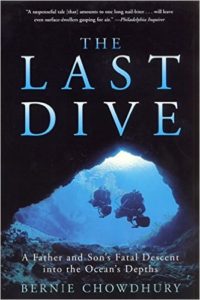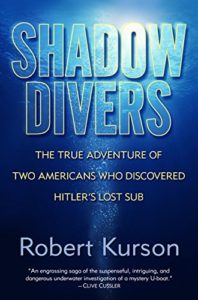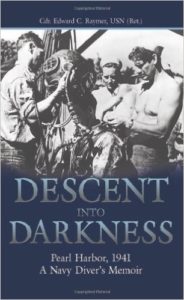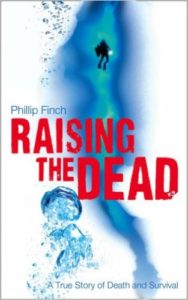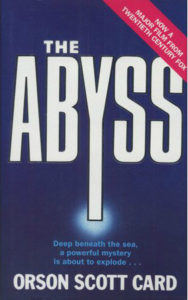If you’re an avid diver and reader, you’ve likely devoured a wide variety of dive books, from classics to entertaining, easy reads such as the Clive Cussler novels. But the haunting dive reads we’ve included on the list below kick up the excitement a notch and feature stories that will remain with you long after you read them. Here are our top picks for the most haunting dive reads.
 “The Last Dive”
“The Last Dive”
by Bernie Chowdhury
“The Last Dive” tells the tale of a father and son’s fatal descent to the U-Who, an unidentified German U-boat. The story is both tragic and almost inevitable. The author, Bernie Chowdhury, is both an expert technical diver and friends with the doomed dive team of Chris and Chrissy Rouse. He wrote the book from a semi-autobiographical viewpoint.
Highlighting episodes from his own life, Chowdhury explores the mentality of technical diving and its history. He juxtaposes this with the Rouses’ dream of diving into fame. East Coast tidbits about tech gear, reveling in artifact fever (i.e., the zeal for goodies from historical wrecks) and exploring the Andrea Doria complement the story.
Sign up for our newsletter and we’ll enter your name in a raffle to win one of two paperback copies of the Last Dive personally autographed by the author![mc4wp_form id=”11919″] |
 “Shadow Divers”
“Shadow Divers”
by Robert Kurson
As a diver, you may recognize the thrill of swimming into and around a wreck. Now imagine discovering a WWII wreck that American and German historians think shouldn’t exist off the coast of New Jersey. Although it sounds too fantastical to be true, that’s precisely the story in “Shadow Divers” by Robert Kurson.
Featuring the same mysterious U-boat as “The Last Dive,” “Shadow Divers” tells the story of the German U-boat’s discovery by famed wreck divers Bill Nagle and John Chatterton. The men and their team spent the next seven years trying to discover the wreck’s identity. While some events overlap with those in “The Last Dive,” this book rather focuses on cracking the overall mystery and history of Hitler’s lost submarine and its crew. Even if you haven’t heard of these legendary Northeast divers and their rivalries, the claustrophobic penetration of a wreck 230 feet (70 m) down in frigid water will instantly sweep you up into 1990s wreck diving.
 “Descent into Darkness”
“Descent into Darkness”
by Cmdr. Edward C. Raymer, USN (Ret.)
This memoir of the Navy’s chief diver, responsible for the Pearl Harbor salvage, details the desperate attempts to save crewmen caught inside their sinking vessels and later the recovery of the sunken wrecks.
The book sucks you into the nightmare conditions of diving on battleships so large that even the crew got lost when the ships were upright, never mind when they sank upside down. Vast quantities of leaking fuel and oil in the water rendered lights useless, so salvagers dove in total darkness. With visibility of two inches or less, they worked by touch alone.
The ingenuity and courage of these Navy men, groping their way through an ink-black maze of war-wrecked ships and floating bodies will leave readers astounded.
 “Raising the Dead”
“Raising the Dead”
by Phillip Finch
In the Kalahari Desert of South Africa lies one of the world’s deepest freshwater caves. It’s only accessible through a small crack in the earth 15 feet (4.5 m) underwater. Two rebreather divers enter planning to raise the decade-old body of a diver resting in almost 900 feet of water. These real-life events cascade into a fatal outcome for one and a close call for the other.
Written in laymen’s terms by a cave diver, the book captures the attention of both recreational and technical divers detailing the drive of diving to extremes and the aftermath of the tragedy.
 “The Abyss”
“The Abyss”
by Orson Scott Card
Books often become movies with varying degrees of success, but rarely are movies transformed into notable books for good reason. By their definition, novelizations embody derivatives. This novel is a rare exception, complementing the movie with luscious detail. It proudly stands on its own as well, as an entrancing sci-fi adventure.
Director and avid scuba diver James Cameron wrote the original screenplay for “The Abyss” and diligently researched all the critical technical aspects. But master storyteller Orson Scott Card provides additional dimension to the story. He based the novel on the screenplay, while the movie was being filmed. Enamored by Card’s writing, James Cameron required the two main actors to read early drafts of their characters’ background. In turn, Card fleshed out parts of the book by watching the actors’ performances.
The story races along with an underwater drill crew and a Navy SEAL team, working to recover a submarine and prevent nuclear destruction. But what they discover deep under the Caribbean and their internal struggles make this a gripping thriller.


